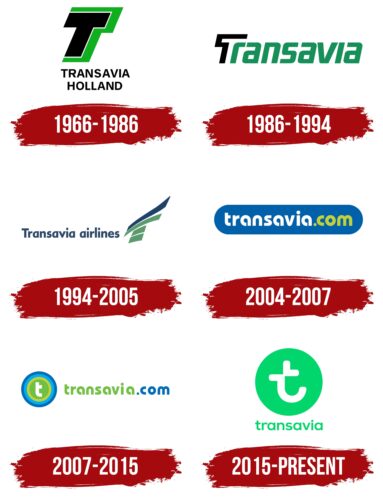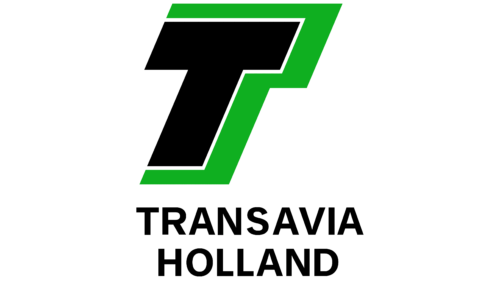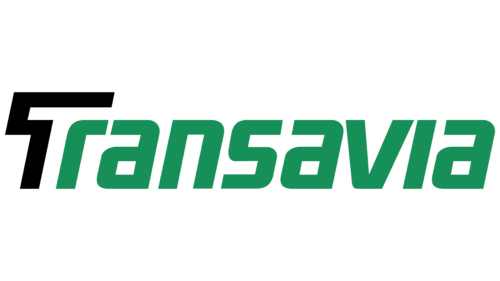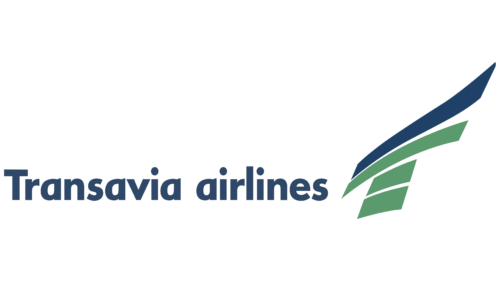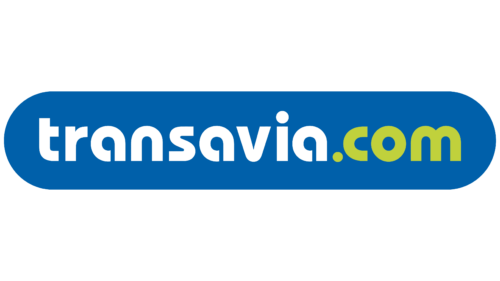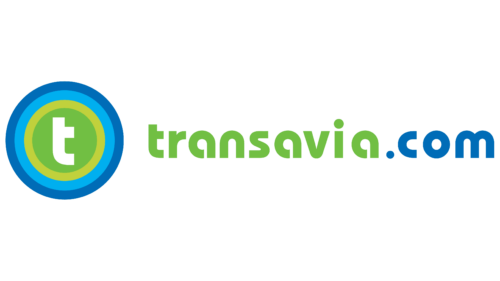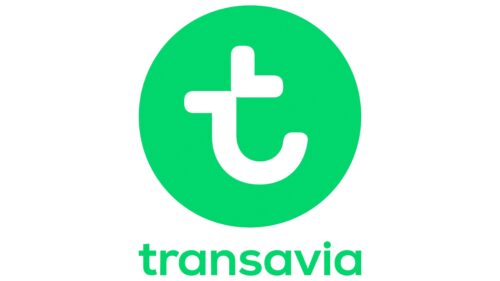The Transavia logo highlights the company’s values. The emblem features harmony, simplicity, and affordability. The symbol conveys that the world loses its boundaries with the company. You can embark on any journey you dream of and achieve your most ambitious plans.
Transavia: Brand overview
In 1965, Transavia took flight in the Netherlands. It was founded on November 14 by a group of private investors led by Chuck Willems. Originally named Transavia Limburg, it operated from Maastricht Aachen Airport. Transavia aimed to tap into the growing charter flight market and offer affordable travel options for tourists.
On November 16, 1966, the airline launched its operations with a charter flight from Amsterdam to Naples using a leased DC-6 aircraft. This inaugural journey marked the company’s entry into the tourism transport sector.
1968, the company made a significant leap by acquiring its first aircraft, a Caravelle III. This purchase allowed the airline to expand its network and increase flight frequencies, strengthening its foothold in the charter flight market.
The 1970s were a period of rapid growth and development. The company expanded its fleet and route network, adding scheduled flights to its charter services and diversifying its business operations.
In 1986, KLM, the Dutch national airline, acquired a 40% stake in the airline, marking a pivotal moment in the company’s history. This partnership provided additional resources and growth opportunities.
By 1991, KLM had increased its stake to 80%, becoming the majority shareholder. This move solidified the airline’s position in the Dutch aviation industry and ensured closer integration with KLM’s operations.
Expanding its reach, the airline launched a subsidiary in France in 1998 named Transavia France. This strategic move aimed to bolster its presence in the French market and extend its European network.
In 2003, the company began transitioning to a low-cost carrier model to compete with the growing number of European budget airlines. The fare structure was simplified, and lower base prices were introduced.
Celebrating its 40th anniversary in 2005, the airline reaffirmed its status as one of Europe’s oldest low-cost carriers.
Following the 2008 Air France and KLM merger, the company became part of the Air France-KLM Group, opening new avenues for collaboration and expansion.
In 2014, Air France-KLM unveiled plans to grow the airline significantly, positioning it as a key player in the battle against other European low-cost airlines.
Marking its 50th anniversary in 2015, the airline highlighted its long-standing resilience in the dynamic aviation market.
Between 2016 and 2019, the company continued to expand its route network, introducing new destinations and increasing flight frequencies on existing routes. The fleet was modernized by ordering new Boeing 737-800 aircraft.
In 2020, the airline faced unprecedented challenges in the aviation industry. The company had to adapt its operations to the new market conditions, focusing on optimizing its route network and reducing costs.
Meaning and History
What is Transavia?
Based in Amsterdam, this low-cost airline offers affordable flights to various popular European and Mediterranean vacation destinations. As a subsidiary of the Air France-KLM Group, Transavia operates a modern and uniform fleet of narrow-body Boeing 737 aircraft configured to ensure efficient and economical operations.
1966 – 1986
Originally known as Transavia Limburg and operational from 1966 to 1986, Transavia had a unique and symbolic first logo. This logo featured a double “T” design: the inner letter is smaller and black, while the outer letter is significantly larger and painted lime green. The design carries a deep meaning, symbolizing the revival and substantial growth of the initially small and inactive Transavia Limburg.
The black color of the inner “T” is surrounded by a white border, which symbolizes extracting the most positive aspects from the company’s past experiences. This element highlights the company’s dedication to retaining the lessons and achievements of the past. The bright lime green of the outer “T” represents a dynamic and energetic progression.
Expanding the company’s operations included adding new flights to Amsterdam, a significant step in Transavia’s development. Changing the name to Transavia Holland marked a new phase in the company’s life and a commitment to strengthening its international standing. The two-tone logo design symbolically represents a bilateral partnership, with each color representing participants from the USA and the Netherlands.
1986 – 1994
The name change to Transavia Airlines significantly influenced the company’s corporate identity, which was reflected in the logo update. The new logo symbol continued the narrative of previous designs with significant modifications that emphasize the company’s dynamic development and modern approach. The symbol retains a small black stripe in the “T,” symbolizing respect for the brand’s heritage and history. The main part of the sign is green, highlighting freshness, growth, and renewal.
This design confirms the company’s commitment to innovation and ability to adapt to changing market conditions. The green color in the logo reflects the environmental awareness increasingly adopted by airlines and symbolizes a continuous drive for the development and expansion of flight operations.
1994 – 2005
After the company came under the management of the new owner, KLM, a rebranding was motivated by the need to review and update the airline’s operations. As part of this update, the company logo was changed, where the letter “T” is now depicted as composed of individual stripes, each rising higher and higher, creating an impression of ascent. This dynamic composition visually conveys the idea of striving upward to new heights and appears almost ready to swoop and disappear into the sky.
The logo uses two colors that enhance the design and carry additional meaning. They symbolize the expansion of the company’s activities: in addition to conducting its flights, the company now operates flights under a code-sharing agreement with another brand. The dark blue color in the logo was chosen deliberately—it represents the rich experience and professionalism that the company has accumulated over the years in the aviation industry.
2004 – 2007
When the company merged with its subsidiary brand Basiq Air, it decided to rename itself transavia.com, a key step in its strategy to simplify and enhance customer services. This new brand reflected the integration with the subsidiary and significantly boosted the company’s recognition in the digital space. It was merging the company name with the website address to speed up booking tickets and ordering charter flights, making these processes more intuitive and accessible for internet users.
The transavia.com emblem was designed as a blue button visually associated with an interactive link leading to the website. This design served as an ornament and performed a practical function, signaling to potential customers the easy access to the airline’s services online. The white font for the company name on this button provided excellent visual contrast and highlighted the novelty of the approach and brand.
2007 – 2015
The 2007 emblem for Transavia was creatively designed in the shape of a dartboard, serving as a symbolic and vivid visual representation of the company’s objectives. This image, composed of multicolored rings, attracts attention with its brightness and design and conveys a deep meaning. The various colors of the rings represent the diversity of the company’s foreign divisions worldwide.
The emblem’s concept focuses on synchronizing the operations of all these divisions to function as a cohesive and efficient whole. The letter “T” is prominently placed at the center of the target, emphasizing the focus on the Transavia brand. This emblem detail highlights that the company’s strategic and tactical efforts aim to achieve a common goal: the prosperity and strengthening of Transavia’s market position.
2015 – today
The modern logo of the airline Transavia reflects its commitment to innovation and its orientation towards the future. The main element of the design is a bright lime green circle, which conveys an impression of energy, youth, and dynamic development. This circle, resembling a halo, symbolizes the sphere of safety and comfort that Transavia aims to provide to each of its passengers.
The central element of the logo is a white letter “t,” rendered in a high-tech style with the upper part shifted to the right. This unique design decorates the logo and emphasizes the brand’s commitment to using scientific advancements to enhance the travel experience. Modifying the letter “t” creates an image of two small airplanes—one symbolically landing and the other taking off. This image highlights the idea of connecting cities and people through the airline’s flights, emphasizing its role in uniting various corners of the world.
Beneath this dynamic composition, the brand name—Transavia—is displayed in lowercase lime green letters. The size of the upper circle visually dominates the inscription, giving it a scale comparable to a planet. This design element underscores the global reach of the company’s activities and its focus on serving passengers worldwide, affirming Transavia’s international status and scope of operations.

